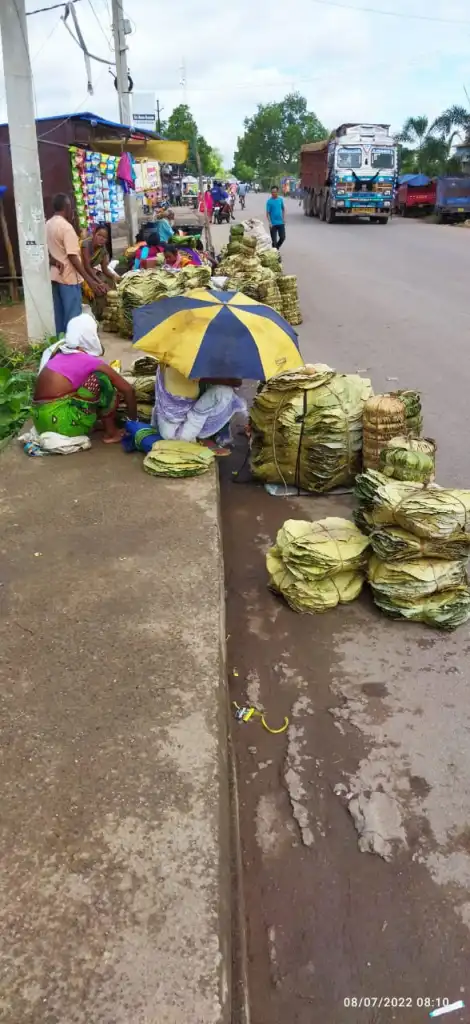Single use plastic enhances utility of jute, cloth bags, Sal leaf items

The government’s blanket ban on single use plastic initially made things difficult for buyers and sellers but the negativity of it all gradually began to disappear with the emergence of paper carry bags that are slowly but steadily making their emergence on the utility horizon. The other positive from the ban on single-use plastic is the employment avenue where people from the economic bottom line are beginning to see a new dawn. Paper carry bags and other utilities of handcrafted material are emerging and giving a boost to the cottage industry.
At the same time, the utility of Sal leaves should not be overlooked either. With the abolition of single-use plastic material, the traditional Sal leaves that were earlier restricted for use by villagers subsisting on forest resources, are now witnessing a steady demand for plates and bowls designed and made with these multi-utility forest treasures. The Sal; leaves are no longer consigned to limited rural use. A look around urban markets proves the tenacity of this observation.
It will not be wrong to gauge that the single use plastic ban has ushered in a revolution of sorts, more in line with a history that has started repeating itself but in a positive vein. Along with paper carry bags, the markets have been seeing a resurgence of jute and cloth bags, Sal leaf utilities and paper packets of various sizes to accommodate grocery and other items according to weights and sizes. The single use plastic ban is proving to be more than a stroke of genius in the sense that apart from staving off health and environment hazards no matter how little or much, the move has revived the employment horizon, especially in the rural sector where paper and Sal leaves are auguring in additional income for the hitherto families on the brink of economic disaster.
Making paper packets of different sizes is not an unknown quantity in urban areas either. Many middle-class and lower middle-class homes used to (and some still do) make paper packets, colloquially called, Thomas and sold them to big and small shopkeepers and pushcart vendors. But the emergence of plastic carry bags spelled literal doom for these folks. Some gave up while some others made these packets half-heartedly. Even sale of old newspapers took a beating. But the ultimate retreat, perhaps almost, of plastic bags, has revived the spirits and income avenues and sale of newspapers at higher prices has proved to be more than a shot in the arm for old newspaper vendors and thonga makers. Some families are full-timers while in other homes, women of the house, during breaks from household chores deftly make these various-sized thongas to supplement the bread winners’ incomes. Glossy magazines for packet makers come in handy but only as per special demands. Otherwise, the newspaper pages continue to be in vogue.
This picture is made clear by young businessman Lalit Chaudhary who stated, “One to one and a half quintals of thongas of various sizes are being used daily in the market. With the revived demand for paper thongas, they are being sold between Rs 70 and Rs 80 per kilogram while those made of good quality paper fetch prices between Rs 90 and Rs 100 per kilogram.”
Jute and cloth bags are also making a comeback. Stationary and other bric-a-brac stores are once again displaying these bags and the sales are looking up. Designer jute and cloth bags too are bouncing back with double zeal. Manu Agarwal, the owner of a mid-sized grocery store said, “I have added jute and gunny bags to my stock. Many customers who buy food grains and other items that cannot be carried in paper thongas or bags need to be taken in jute or cloth bags. They naturally opt for these that are readily available in my shop. This suits me financially, no matter how much money I make but also the customers who can carry their purchases safely home.”
Amid all the sunshine after the literal demolition of the ‘Single Use Plastic Citadel’ it would be grievously wrong to overlook the sunshine on the otherwise humble Sal leaves. The urban population mostly used Sal leaf open packets called Donas for distributing consecrated food (Prasad) among devotees after puja or worship while the rural folks had multipurpose use not only as Donas but also as other forms based on necessity. Some made flat plates with Sal leaves stitched together with small, thin wood wickers.
These also served the purpose of laying out cut fruits to be used for pujas. They remained necessities for picnickers too. But there ended the utility part of Sal leaf make-shift urban necessities but continued to prevail in rural climes. But, as they say, “Necessity is the mother of invention,” and so it came to be that plates and bowls made of Sal leaves started their appearance in the market and are destined to remain there as long as man remains attuned to factors of health-consciousness.
